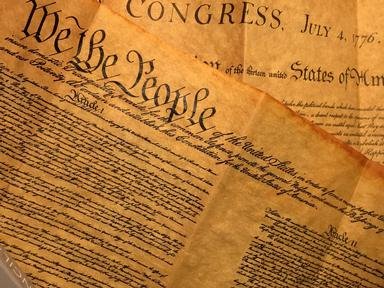Quiz Answer Key and Fun Facts
1. Twelve amendments were originally proposed to the US Constitution in 1789. Ten we know as the Bill of Rights, one eventually became the 27th amendment, and one failed to be ratified by the states. How many more states did this Congressional Apportionment Amendment need (at its closest) in order to be ratified?
2. In 1810, the Titles of Nobility Amendment was presented before Congress, which passed easily in both the House and Senate. It is believed to have been a reaction against Jerome Bonaparte, Napoleon's nephew, who had an American son (getting citizenship through his mother) that his mother wanted to receive an aristocratic title. What would this amendment have done?
3. In 1973, the Human Life Amendment was proposed in Congress by Lawrence Hogan of Maryland. It never came up for a vote until its seventh iteration in 1981, when it fell 18 votes short of being passed. What Supreme Court decision, made in the same year the amendment was originally introduced, was this amendment designed to overturn?
4. Seeing the winds of change coming, Representative Thomas Corwin proposed an amendment in February 1861 that barely passed both the House and Senate, the latter two days before Abraham Lincoln swore in as president. The Corwin Amendment passed despite seven states having already seceded from the Union, thereby not having a vote in Congress. What would the amendment have done if the states had ratified it?
5. In 2004, Representative Gene Green of Texas introduced the "Every Vote Counts Amendment". Although it never made it out of the Committee on the Judiciary, it held some popular support after what had transpired during the 2000 presidential election. What did the amendment call for?
6. A small Protestant sect called the Covenanters started a large movement in 1863. They set up a conference hosting 11 denominations in the midst of the Civil War to discuss the war and religion. It was decided that the war was punishment for not including God in the Constitution, and pushed for an amendment to change that. Specifically, what part of the Constitution did the Christian Amendment aim to alter?
7. The Continuity of Government Commission recommended an amendment in 2003 that would only be enforceable if at least one-quarter of the House of Representatives were incapacitated (the Senate already had measures in place). The entire commission was put into place as a response to what event?
8. Between World Wars I and II, the United States entered an isolationist phase that would eventually end with the attacks on Pearl Harbor. However, in 1935 Louis Ludlow wanted to severely restrict the ability for the nation to go to war. What would the Ludlow Amendment have required in order for Congress to officially declare war (unless attacked first)?
9. The Nineteenth Amendment guaranteed the right to vote for women in the United States, but other forms of discrimination were not protected against. In 1923, the Lucretia Mott Amendment was proposed to give men and women equal rights, but it never hit the floor. By 1972, it had earned a more well-known name and was approved by Congress, but failed to be ratified by enough states. What was this amendment called?
10. In 1978, Congress passed the District of Columbia Voting Rights Amendment, which would have given Washington, DC full representation in Congress and treatment as a state during presidential elections. Though it failed state ratification by a wide margin, what previously-ratified amendment would it have repealed in order to be put in place?
Source: Author
illiniman14
This quiz was reviewed by FunTrivia editor
stedman before going online.
Any errors found in FunTrivia content are routinely corrected through our feedback system.

